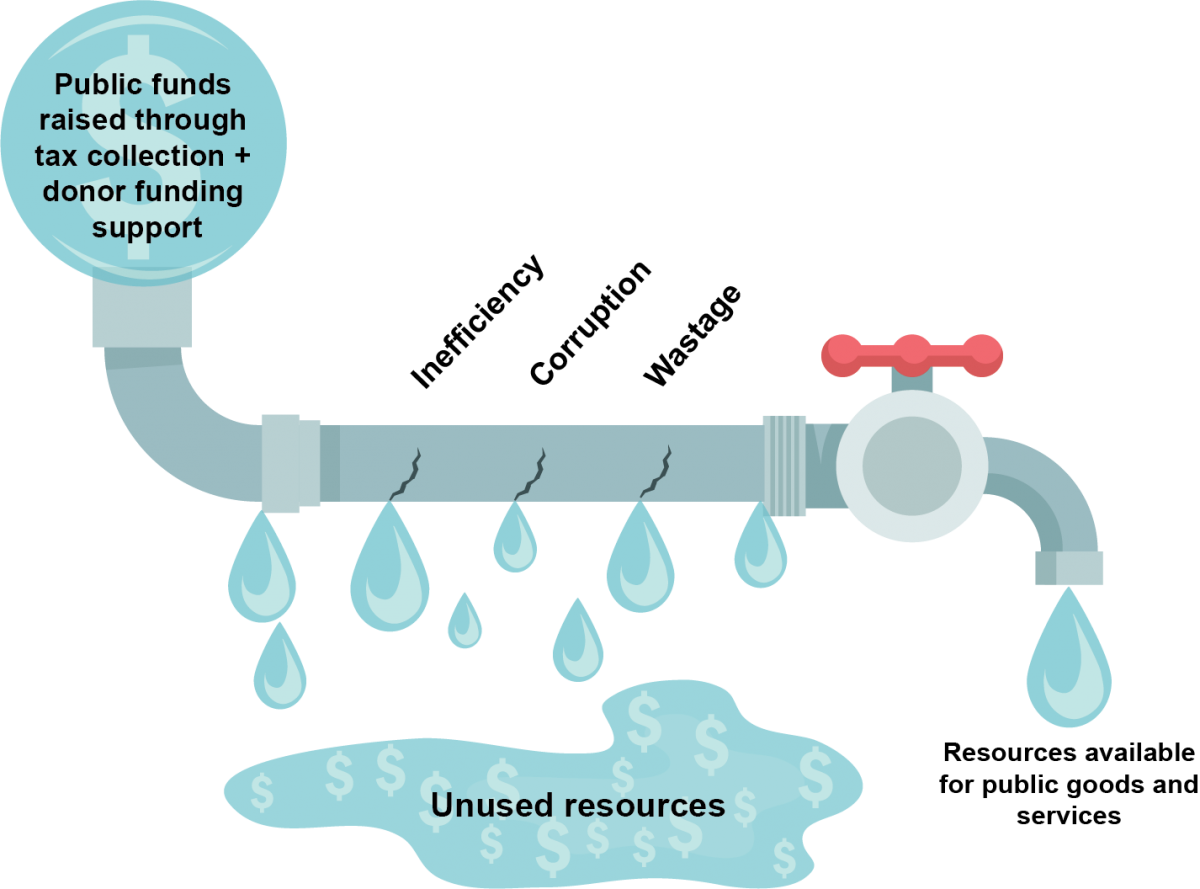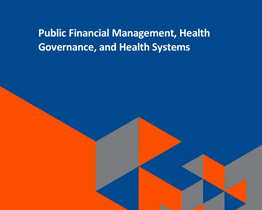What is Public Financial Management?
A public financial management (PFM) system is a set of rules and institutions, policies, and processes that govern the use of public funds across all sectors, from revenue collection to monitoring of public expenditures. PFM policies vary by country and can cover issues related to tax law, budget management, debt management, subsidies, and state-owned enterprises. A well-functioning PFM system is critical to ensuring accountability and efficiency in the use of public financial resources, while a weak PFM system can result in significant wastage of scarce resources (Figure 1). PFM is particularly relevant to health financing, as most resources for health tend to come from public budgets. In particular, PFM systems influence how much funding is available and allocated to health, the effectiveness of spending on health, and the level of flexibility in use of health funds.
Figure 1. PFM: Leaking pipe analogy

There are three main steps in the budget cycle, a central component of every PFM system: budget formulation, budget execution, and budget monitoring. The budget planning process usually involves collecting estimates from all ministries and departments on the financial resources required to carry out their objectives, prioritizing those needs, and then allocating funds across different areas based on prioritized needs and the budget ceiling, which is usually set by the ministry of finance. Once a level of funding is confirmed, ministries and departments receive funding in the following fiscal year to pay public or private providers for goods and services. Budget monitoring ensures that ministries and other entities comply with laws and regulations, including filing financial reports and audits and ensuring that correct financial controls are in place.
In the health sector, budget formulation and execution are ideally aimed at improving equity and access to high-quality services for priority health areas, geographies, and populations. If the PFM system, which manages the collection and flow of public funds, is not aligned with the health financing system, which raises revenue, pools funds, and purchases goods and services specifically for health - health funds may not be optimally used. For example, PFM policies may restrict whom the government can contract with to provide health services, limiting the ability of the government to reach certain underserved populations. Or a decentralized PFM system may be a barrier to instituting a health insurance scheme that pools funds at the national level, which could perpetuate fragmentation in the health sector.
Why is PFM important for family planning?
PFM Improvements Increase Resources for Health and Family Planning in Uganda
As Uganda underwent decentralization, including payroll functions, the country removed ghost health workers from the government payroll. Thirty percent of the significant savings achieved were used to recruit new health workers. This increase in health worker resources benefits multiple health areas, including family planning.
PFM is an integral component of securing sufficient and efficient funding for family planning. Stakeholders should consider how family planning budgets are formulated, executed, and monitored, and how family planning ties into the greater PFM system. For example, many countries have included a budget line for family planning in their national government budgets, but if adequate funding is not then allocated in the budget formulation stage, family planning services will suffer. Also, in many countries, ministries of finance restrict the percentage of the budget that can be released and used by a department or ministry in each quarter of a fiscal year. If family planning procurement is not aligned with the PFM system for fund disbursement, there could be a shortage of funds to procure commodities to deliver services, hindering access and choice of method for women and their partners.
In addition to ensuring family planning financing aligns with the greater PFM system, stakeholders should consider how ongoing PFM reforms may have ripple effects on family planning through overall changes in the health system. For instance, improvements in tax collection that increase overall government revenues could lead to increased allocations to the health sector and family planning, if prioritized in the government budget. Similarly, many countries have reformed how they formulate budgets over the last couple of decades, presenting an opportunity for improved budgeting for health and family planning. Through introduction of medium-term expenditure frameworks that project funding levels for multiple years, health and family planning funding levels could become more predictable. Also, by shifting from line-item or input-based budgeting to program-based or output-based budgeting, countries may have a better understanding of the funding requirements by program to achieve specific outcomes, including increases in use of modern contraception, which can help improve allocation decision-making.





